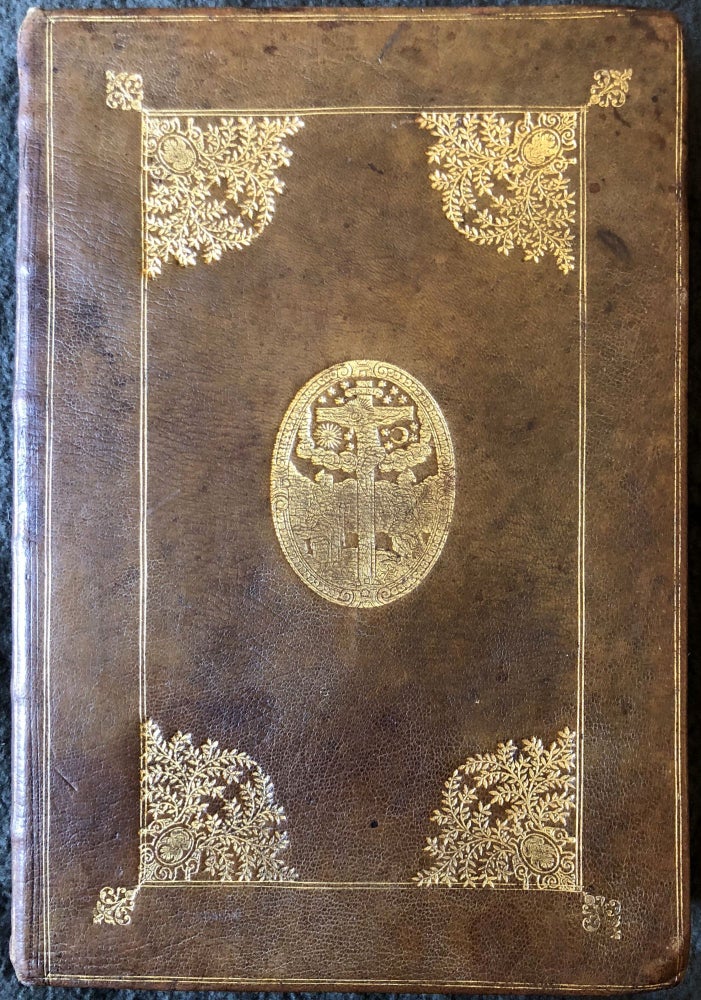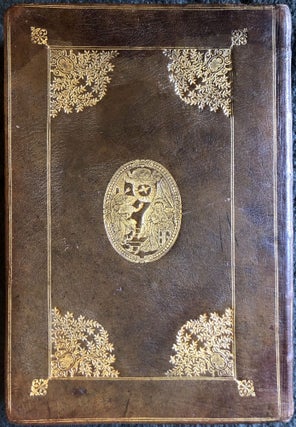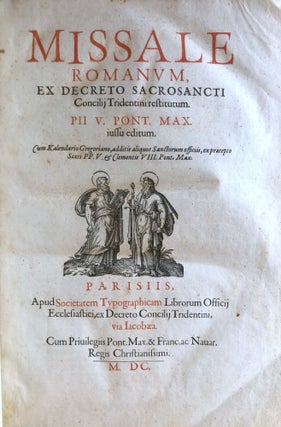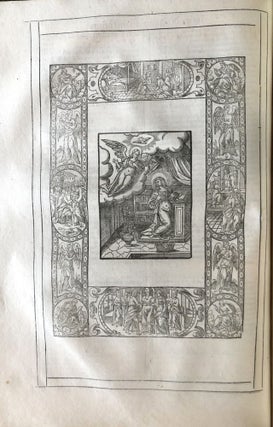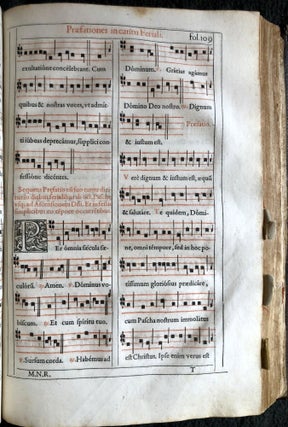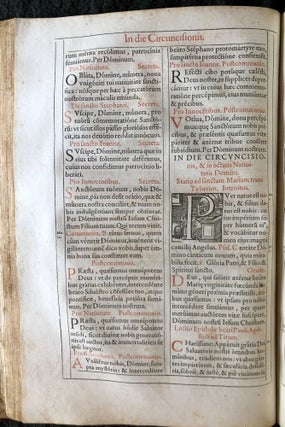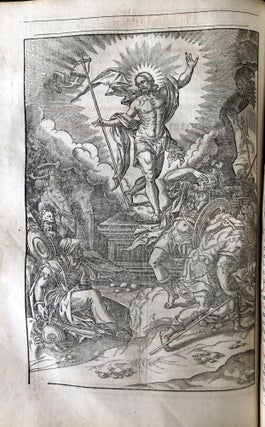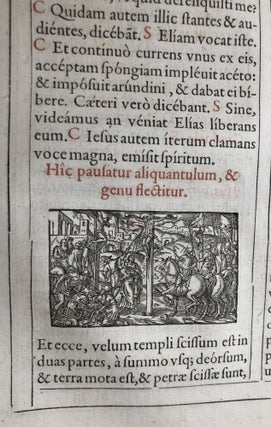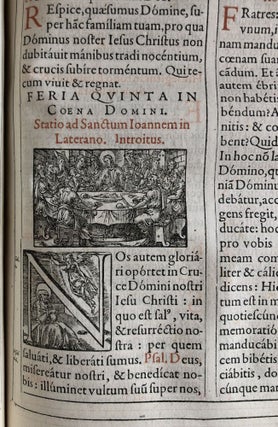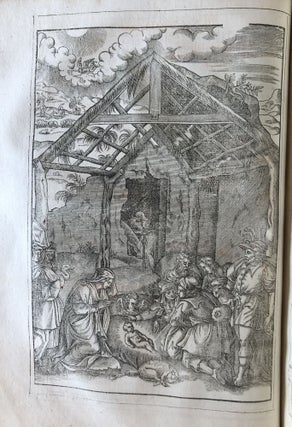Missale Romanum, ex decreto sacrosancti Concilii Tridentini restitutum. Pii V. Pont. Max. iussu editum. Paris: the Associated Booksellers to the Church, 1600.
Folio (362 x 245 mm). Collation: ã6 ê6 î4 (i4 blank) õ6 ũ6 ãã6 êê4; A-Z Aa-Yy6. [38], 228, 42 leaves. Double column, printed in red and black, double rule page-borders throughout. 57 pages with printed music (staves red-printed). Woodcut title illustration of Saints Peter and Paul, seven full-page woodcuts (the first in two blocks: a woodcut border and small Annunciation cut), five small woodcut vignettes including two repeats, and approximately 368 historiated initials in various sizes and from various series. Small tear to corner of title-leaf, occasional foxing, very occasional offsetting of red ink, small stains in gutters in quire O, finger-soiling in Canon (quire X), small rust-hole in f. 212 (NN2) affecting 3 letters, last few leaves with narrow marginal dampstain and slight creasing to upper fore-corners. Bound in contemporary French gold-tooled and -stamped light brown goatskin, covers paneled with double fillets, inner panel with fleurons at outer corners, inner corners with large stamp of leafy branches emerging from a small medallion with winged cherub’s head, large central oval medallion of the Crucifixion on upper cover and Annunciation on lower cover, smooth spine (with recessed cords) decorated with overall double fillet panel with tiny fleurons at corners, gilt edges, plain endpapers, remains of numerous fore-edge tabs in paper, pale green or pink silk, and black silk for the Mass for the Dead. Corners bumped, slight wear, front cover slightly rubbed, a few small holes to lower cover, foxing to endpapers. Provenance: contemporary inscription in French on front flyleaf listing “Messes pour tous les iours de la sepmaine” (Masses for every day of the week); loosely inserted armorial papercut, unidentified arms (lion rampant, on a chief three roses).
Unrecorded issue of an imposing post-Tridentine Missal, in a fine Parisian gold-tooled binding. The woodcut illustrations of this copy differ from the other known copies of this edition, which are illustrated with engravings. The binding tools appear on other books published by the same publishing consortium, and have been associated with religious lay confraternities founded by Henri III in the 1580s.
This exceptional copy is of interest for the history of publishing, printing, illustration, and binding; it raises questions about the very concept of an edition, about the transmission of images, and about the relations between printer-publishers, bookbinders, and book buyers in the hand-press period.
In 1570, with the papal bull “Quo primum,” Pope Pius V imposed uniformity on the rites of Mass, previously a hodge-podge of different local traditions. That bull was printed in all subsequent missals; it is accompanied here by papal and royal privileges which supply crucial information concerning the publishing history of this edition. Jacques Kerver was the first French libraire to obtain a privilege for the publication of liturgical works. When he died in 1583, the privilege passed to his widow, who ceded it to a consortium of booksellers: Sebastian Nivelle, Guillaume Chaudière, Guillaume de la Noue, Michel Sonnius, and Thomas Brumen (cf. Renouard, Imprimeurs et libraires parisiens du XVIe siècle, IV, 22). That privilege expired on 22 December 1595. This edition includes Papal and Royal renewals of the Kerver privilege for the printing of “sacred books” (Missals, Breviaries, and Offices of the Virgin), granted respectively by Clement VIII and Henri IV, both on 4 April 1596. For Thomas Brumen, who had died in 1588, the Royal privilege substitutes his son-in-law and heir Jean Corbon II, and adds the names of Claude Chapelet, identified as bookseller to the Academy, and Jamet Mettayer and Pierre L’Huillier, respectively Royal printer and Royal bookseller (Mettayer was also the official printer for the Royal confraternities).
The preliminary matter further includes the reformed (Gregorian) Paschal calendar for the years 1582 to 1700, a table of moveable feasts for 1589 to 1621, the Rubricae generalis missae, the Ritus servandus in celebratione Missae, and an index of Saints’ names. The second part of the Missal, separately paginated, contains the Commune Sanctorum. The subjects of the full-page illustrations are: the Annunciation: a small cut within an historiated woodcut border in twelve compartments, showing four scenes from the life of the Virgin, alternating with angels and the four Evangelists (fol. êê4v); the Nativity (B4v), Crucifixion (T6v, opening the Canon), Resurrection (X4v), Pentecost (AA1v), Last Supper (BB3r), and Last Judgment (PP2v). These monumental woodcuts, influenced by Italian and Flemish mannerism, derive from various engraved sources, including at least one engraving (the Resurrection) used by Jamet Mettayer in an Office of the Virgin published in 1586.
The five smaller woodcuts, printed from three blocks, include a Crucifixion, showing Longinus piercing the side of Jesus (repeated twice), the Last Supper, and a smaller, primitive Crucifixion cut. Noteworthy are the many historiated initials. Ruth Mortimer, describing an edition by Kerver from 1574, noted that the elaborate historiated initials, containing “figures of the saints, the Evangelists, and ... New Testament scenes, may be attributed to the same artists who worked on the illustrations. The blocks are so detailed as to give the impression of additional illustrations rather than initials.” As in previous editions, the initials were chosen carefully here to match the text: for example, the four Rs opening the word Requiem in the Mass for the Dead (ff. XX5 ff.) incorporate a skeleton and funeral scenes.
The full-page woodcuts had appeared previously in the Kerver-consortium’s 1588 edition (cf. an illuminated copy offered by Breslauer in 1981, cat. 104/II, no. 192). Only a few copies of these repeatedly printed Paris post-Tridentine Missals survive in public collections, and precise descriptions are few. The most thorough description is that by Ruth Mortimer of the Harvard copy of the 1574 Kerver edition. Both that edition and the 1583 edition, of which there is a copy at the Newberry Library, are illustrated with only two full-page woodcuts, including the canon cut of the Crucifixion used here, and numerous smaller woodcuts. (The title of the 1574 edition bears the same Peter and Paul cut, while the 1583 edition has Kerver’s device.)
The present copy represents a previously unrecorded variant issue of the 1600 edition, of which the two other copies located (at the Austrian National Library [digitized] and with Sokol Books, catalogue 65/64) are illustrated with engravings, all but one of which differ iconographically from the present woodcuts. (The exception is the aforementioned Resurrection woodcut, which is copied in reverse from the engraving.) The typesetting, other than the title, appears to be identical, but rather than a letterpress title-page and woodcut full-page illustrations, the other copies have an engraved title and seven full-page engravings. Another variant setting occurs in quires M and N: both issues have the small Longinus woodcut on M1v, but the spaces here filled by 3 small woodcuts (one used twice) are left blank in the cited copies.
The existence of multiple editions of these post-Tridentine Paris Missals has been documented; Mortimer, for example, noted that in 1574 Kerver printed two folio editions, as well as quarto and octavo editions. From the early 1570s to the end of the century, these liturgical books, now rare, were churned off the presses to meet the needs of priests and clerics throughout France and beyond (several copies of the Kerver or Kerver-consortium editions survive in Spanish and Italian libraries). Under these circumstances the existence of multiple editions and variant issues is not surprising.
The attractive Parisian binding shows signs of hasty finishing: the cornerpieces, using a popular cherub’s head and leafy branch motif, are single stamps, and those on the upper cover are unevenly placed, so that three of them overlap the double fillet panel. It is, however, a luxury binding of high-quality goatskin, and its decoration is charged with meaning, which remains to be completely teased out. Several variants of the Crucifixion and Annunciation medallions were used on the bindings of a number of devotional books published by the present publishing consortium, or by its individual members. A few of those bindings bear a motto (Spes mea Deus) used by members of the Confraternity of Penitents of the Annunciation, founded by Henri III in 1583. Possibly by extension, the Crucifixion stamp itself has been associated with the confraternity and with the three other “congregations” established by that devout monarch in 1583-85. The same large Crucifixion and Annunciation medallion stamps were used in a similar center- and cornerpiece design on the aforementioned Breslauer copy of the 1588 edition of this Missal, and in a dated binding from 1599 covering a 1508 Verard book of hours in the British Library (shelfmark c29f16, reproduced in the BL Database of Bookbindings). In both cases, the corner feuillage stamps are different but the central medallions appear to be identical to those on this binding.
Similar but not identical stamps, besides those cited in the sources below, are found on: a copy of Mettayer’s 1586 Pseaultier de David, recently offered by the Paris booksellers Laurent Coulet and Ariane Adeline, in their catalogue “1586: Jamet Mettayer et les Confréries de Pénitents”; an Officium beatae Mariae Virginis (Paris: apud Societatem Typographicum, 1586), using both the Annunciation and Crucifixion medallions, set within a fanfare design (Bibliothèque Sainte Geneviève, Réserve 8 Z 6685 INV 9940); and an Office de La Vierge published by Mettayer in 1586 (BnF Réserve B. 1654, Lacombe 486). A book of hours for the use of Amiens (Paris: for Guillaume de La Noue, 1589), bound with several devotional tracts (BnF Réserve B-27949; Lacombe 492), has a different Annunciation stamp but apparently the same Crucifixion stamp. Coulet and Adeline established a typology of 9 different Crucifixion stamps, or 8 stamps and one variant, the one used here being no. 8.
Given these facts, the possibility cannot be excluded that the publishers were involved in commissioning the bindings, of this copy and of the other “Crucifixion medallion” bindings found on their imprints.
USTC 137500 (Austrian National Library only, variant issue - not in their OPAC). Cf. Harvard/Mortimer French 378 (8 June 1574 edition). Not in Weale-Bohatta or Amiet. On the binding, cf. Hobson & Culot, Italian and French 16th-century Bookbindings (1991), 62; Claude La Charité, “Henri III, Le miroir des religieux (1585) de Louis de Blois et `la troisiesme couronne à frere Henri de Valois,’” Revue de Bibliothèques et Archives du Québec, no. 2 (2010), online; Needham, Twelve Centuries of Bookbindings (1979), 82.
Price: $14,000.00

